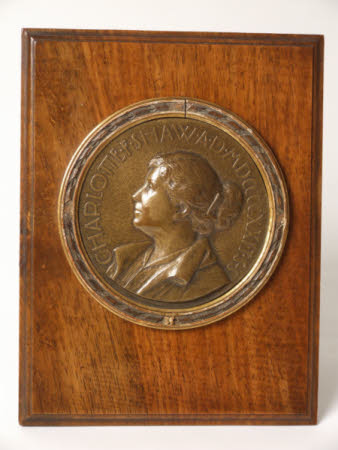Bronze medallion of Charlotte Shaw
Theodore Spicer- Simson (1871 - 1959)
Category
Art / Sculpture
Date
1921
Materials
Mahogany and bronze
Measurements
8.25 ins (h)6.25 ins (w)4.75 ins (dia)
Order this imageCollection
Shaw's Corner, Hertfordshire
NT 1275406.2
Summary
A circular bronze medallion of Charlotte Shaw by Theodore Spicer-Simson (1871-1959), quarter-length in left profile. Set in a gilt wood surround on mahogany plaque with hinged support behind.One of a pair of medallions: the companion piece is a medallion of Bernard Shaw (NT 1275406.1)
Full description
A circular bronze medallion of Charlotte Shaw by Theodore Spicer-Simson (1871-1959), quarter-length in left profile. Gilt wood surround on mahogany plaque with hinged support behind. Marks and inscriptions: signed Around the head - CHARLOTTE F. SHAW AD MDCCCCXXI T.S-S. Theodore Spicer-Simson (1871-1959) was an American-British sculptor and medallist who lived and worked in Paris, London, and the United States. He revived the ancient art of the portrait medallion. In 1921 he sculpted medallions of Shaw and Charlotte. Spicer-Simson later recalled how he met Shaw: “I called on him with a letter from Lady Scott, the widow of the great explorer of the South Pole. I had known her in Paris as Miss Katherine Bruce. She was a friend of George Bernard Shaw and had done a statuette of him so, letter in hand, I presented myself at 10 Adelphi Terrace… after I had shown Shaw some of my work he said he would sit with pleasure.” In January 1922 Shaw received the medallion and was pleased with the result, writing to Spicer-Simson: “It comes out very well in the bronze. The photograph in your last letter, the one for the American publication, is first-rate in its reproduction of the modelling.” After Spicer-Simson had finished the portrait of “GBS”, Shaw wrote to him requesting that he sculpt a medallion of Charlotte: “My wife will give you a sitting at 10.30 any morning when in town…I formally commission the medallion (in case I fall down dead or something) for two hundred pounds; not more than five casts will be required.” Shaw famously included a reproduction of his Spicer-Simson medallion on the cover of his last work Bernard Shaw’s Rhyming Picture Guide to Ayot St Lawrence, in 1950. When Charlotte Shaw’s medallion was finished, Spicer-Simson wrote to her saying that the National Gallery of Ireland wished to buy a replica, but she replied: “I must tell you that I have spent a great part of my life avoiding the making and diffusion of pictures of myself. I am superstitious about it…It is a kind of mania with me.” However after her death in 1943, Shaw granted Spicer-Simson permission to reproduce Charlotte’s medallion. Shaw explained: “She was sensitive about her personal appearance and resented the slightest attempt to pass her off as a conventionally pretty woman. The result was that she could not bear any sort of portraits…Your medallion, which was kindly, if not flattering – a bit ‘sonsie’ [comely] perhaps – shared the general fate. But there is now no reason why you should not reproduce the medallion, ad lib.” (Shaw to Spicer-Simson, 13 January 1946). The Shaw correspondence quoted in Theodore Spicer-Simson, A Collector of Characters: Reminiscences of Theodore Spicer-Simson (University of Miami Press, 1962). (Alice McEwan, 2020)
Provenance
The Shaw Collection. The house and contents were bequeathed to the National Trust by George Bernard Shaw in 1950, together with Shaw's photographic archive.
Marks and inscriptions
Around the head - CHARLOTTE F. SHAW AD MDCCCCXXI T.S-S
Makers and roles
Theodore Spicer- Simson (1871 - 1959), sculptor
